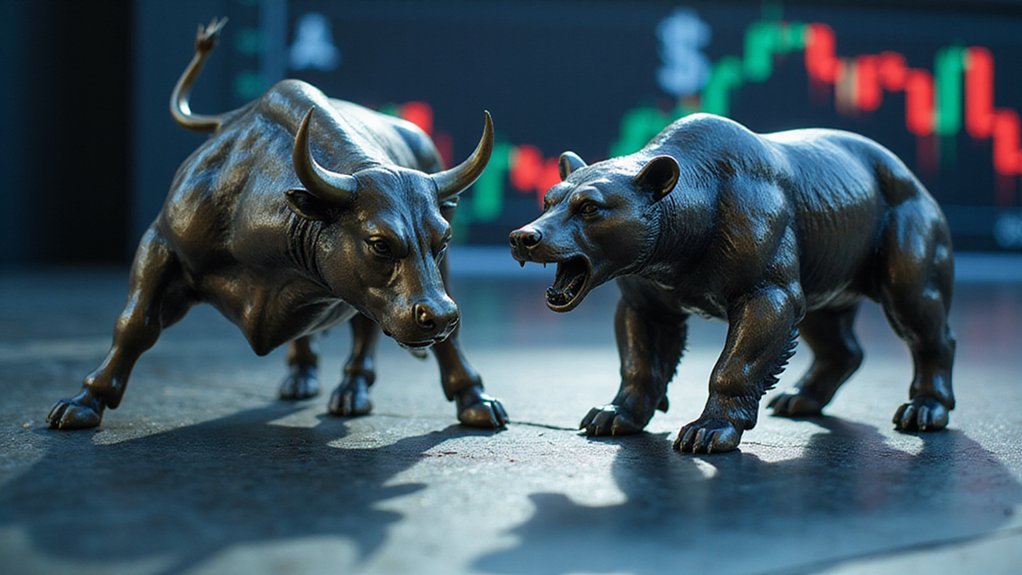Bull and bear markets represent the market’s bipolar nature—optimism versus pessimism incarnate. Bulls charge upward (prices rising at least 20%), flourishing amid economic growth, robust corporate earnings, and increasing employment. Bears swipe downward, thriving in uncertainty with declining profits and rising unemployment. These cycles, averaging 4.2 years for bulls and 11 months for bears, create distinct investment landscapes. The shrewd investor recognizes that both environments offer unique opportunities—one simply needs different weapons for each hunt.

The contrasting forces of optimism and pessimism that drive financial markets have, since time immemorial, been personified as bulls and bears—creatures whose distinctive attacking postures mirror the directional momentum of securities prices.
Market sentiment oscillates between bull and bear, mirroring humanity’s eternal dance between hope and fear.
Bull markets charge upward, fueled by economic prosperity and investor confidence, while bear markets swipe downward, reflecting economic contraction and widespread uncertainty.
The financial community has settled on the somewhat arbitrary threshold of 20% price movement to demarcate these opposing market conditions—a numerical boundary that, while imperfect, provides a convenient shorthand for categorizing the market’s temperament.
During bull markets, economic indicators bloom like spring flowers: employment rises, corporate earnings exceed expectations, and consumer spending strengthens.
This economic renaissance naturally translates to surging securities prices as investors—emboldened by the prevailing winds of prosperity—increase their market participation and risk tolerance.
Trading volumes swell accordingly, creating a self-reinforcing cycle of liquidity and appreciation.
Intermittent corrections (those bothersome but ultimately manageable price declines) may interrupt the upward trajectory, yet the primary trend persists with the tenacity of its namesake.
Conversely, bear markets emerge when economic foundations begin to crumble.
Unemployment climbs, corporate profits decline, and investor sentiment sours faster than milk left in summer heat.
The resulting pessimism manifests as widespread selling pressure, with many participants retreating to safer harbors¹.
Trading activity typically diminishes—though occasional volume spikes occur during panic-driven selloffs—and price charts resemble ski slopes rather than mountain ascents.
Market volatility, that perennial companion of uncertainty, intensifies during these periods, testing even the most stoic investor’s resolve.
Risk management strategies necessarily evolve with market conditions.
Bull markets reward equity exposure and growth-oriented positions, while bear markets favor defensive sectors, fixed income, and—for the particularly skeptical—cash equivalents.
The savvy investor recognizes that both conditions present distinctive opportunities: bull markets for appreciation, bear markets for accumulation at discounted valuations.
Major market indexes like the S&P 500 serve as key indicators to determine whether we’re experiencing a bull or bear market cycle.
Historical data shows that since 1942, bull markets have demonstrated remarkable staying power, lasting an average of 4.2 years compared to bear markets’ typical 11-month duration.
Historical examples like the post-World War II boom demonstrate how powerful and sustained bull markets can transform economies and create generational wealth for patient investors.
¹Treasury securities, gold, and utilities historically perform better during market downturns.
Frequently Asked Questions
How Long Do Bull or Bear Markets Typically Last?
Bull markets enjoy remarkable longevity, typically enduring between 1,000 to 1,866 days (roughly 2.7 to 5.1 years) with an impressive average gain of 114.9% to 180%.
Their ursine counterparts, bear markets, mercifully conclude far sooner—averaging merely 409 days (approximately 1.3 years) while inflicting average losses of 35-36%.
The asymmetry is striking; bull markets consistently demonstrate greater duration and magnitude than their bearish counterparts.
Can Both Markets Exist Simultaneously in Different Sectors?
Yes, bull and bear markets can indeed coexist across different sectors simultaneously—a phenomenon market veterans recognize as sector divergence.
While technology stocks might be soaring on innovation narratives, traditional energy could be languishing under regulatory pressures.
This sectoral dichotomy creates the fascinating scenario where astute investors can find pockets of opportunity (bull markets) even within broader downturns, or conversely, identify overvalued sectors ripe for correction amid general euphoria.
What Triggers the Transition Between Bull and Bear Markets?
Market shifts stem from distinct catalysts: structural shifts involving profound financial imbalances and asset bubbles; cyclical factors tied to economic phases and interest rate policies; event-driven shocks like pandemics or geopolitical crises; and psychological/technical elements where investor sentiment and automated trading magnify trends.
Each shift type follows its own resolution pattern—structural bears requiring valuation adjustments, cyclical ones responding to monetary easing, and event-driven markets stabilizing once the precipitating shock subsides.
How Should Retirement Portfolios Adjust During Market Shifts?
Retirement portfolios should adapt to market shifts through strategic diversification and tactical withdrawal adjustments.
During changes, retirees might employ the bucket approach—allocating 1-2 years of expenses to cash, 5-8 years to fixed income, and long-term needs to equities.
Reducing withdrawal rates below the standard 4% during downturns (while perhaps cutting discretionary spending) can extend portfolio longevity.
Meanwhile, maintaining a 1-3 year cash cushion helps avoid the dreaded sequence-of-return risk that can decimate otherwise sound retirement plans.
Are There Reliable Indicators to Predict Market Direction Changes?
While certain indicators offer probabilistic insights into market direction changes, none are infallibly predictive (despite what financial television might suggest).
Technical signals like MACD divergences, moving average crossovers, and volume-price discrepancies can identify potential inflection points.
Put/call ratios and RSI extremes function as contrarian indicators, occasionally presaging reversals.
The Ichimoku Cloud’s framework proves useful for trend confirmation, though these tools remain most effective when applied in complementary combinations rather than isolation.









